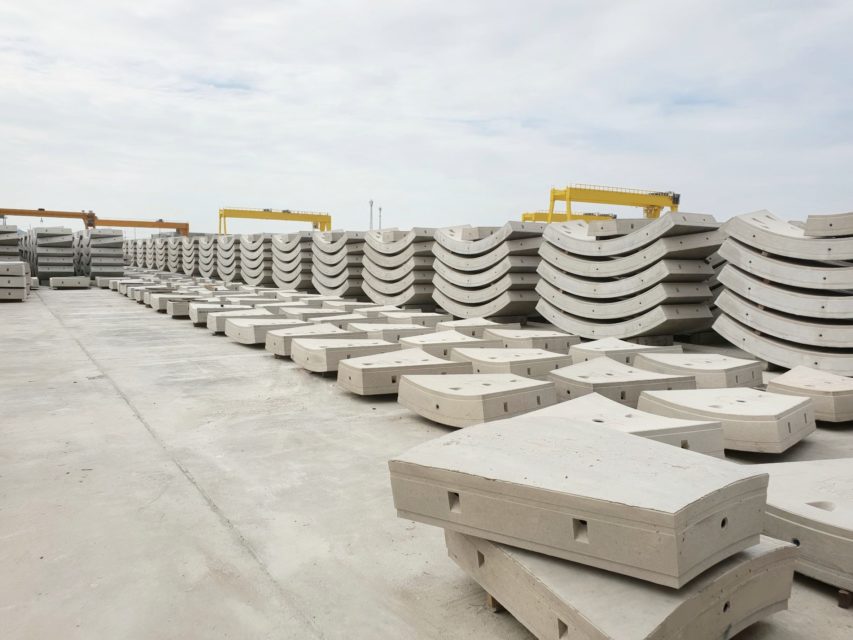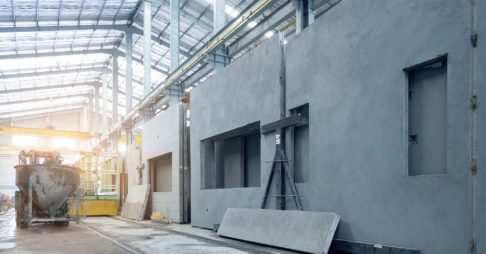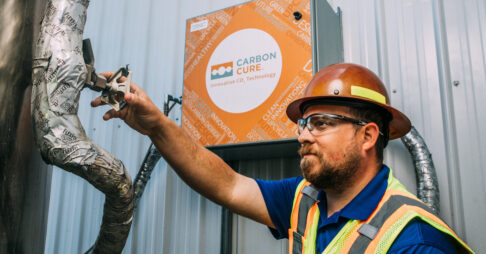The green building movement is on the rise. There are currently over 335 active embodied carbon projects valuing over $13 billion in the United States alone, and from 2020 to 2021, spec requests for embodied carbon and/or CarbonCure projects grew by 11.23%.
This growing trend was discussed in-depth in a recent webinar co-hosted by CarbonCure and the Precast/Prestressed Concrete Institute (PCI). During the webinar, sustainability expert Emily Lorenz, PE, Consulting Engineer, and Allison Palmer, Senior Manager Market Development at CarbonCure, discuss what precast and prestressed concrete producers need to know about embodied carbon and the best methods for staying ahead of the curve.
The Meaning of Embodied Carbon
Embodied carbon is the greenhouse gas emissions associated with the whole life cycle, cradle to grave, of a product or building — manufacturing, transportation, installation, maintenance and disposal.
But the term ‘embodied carbon’ is sometimes used as shorthand with others such as ‘greenhouse gas emissions (GHGs),’ ‘carbon footprint’ and ‘carbon dioxide emissions’ used interchangeably. “All of those terms play a role. And, unfortunately, in the marketplace, there isn't a standardized way that people use them,” said Emily.
For a technical definition of embodied carbon, Emily recommends the one used in the ISO standard for carbon footprinting (ISO 14067-18): Sum of GHG emissions and GHG removals in a product system, expressed as CO2 equivalents and based on a life cycle assessment using the single impact category of climate change
Source: ISO 14067-18, Greenhouse gasses — Carbon footprint of products — Requirements and guidelines for quantification
The colloquial use of the term ‘embodied carbon’ can cause confusion. “When people say embodied carbon, it can mean lots of different things. One of the first things you want to do when you have an owner or a client come to you and ask you about embodied carbon is to find out what they think it means,” said Emily.
The Push to Reduce Embodied Carbon
Over the last 10-15 years, the architecture and engineering community has focused on reducing the operational carbon of buildings. Now, the focus is turning to embodied carbon. “The next big thing to tackle in terms of reducing greenhouse gas emissions are embedded in the materials themselves that we use to build,” said Emily.
Buildings generate 40% of the world's annual greenhouse gas emissions and the world's building stock is expected to double by the year 2060. While operational carbon can be addressed retroactively, the same isn’t true for embodied carbon.
“There's nothing we can do to turn back the time on the embodied carbon footprint of the building,” said Allison. “So it's really important to take strategic measures in the building design phase to get ahead of the curve and reduce that carbon footprint as soon as possible.”

How to Calculate Embodied Carbon for Precast
Ideally, the calculation of embodied carbon includes greenhouse gas emissions from all life cycle stages. But doing so can be challenging for certain products, like precast concrete products engineered to order.
“You would have to do an analysis for every piece and every application for every function. You'd have to know how long that piece was going to be in the structure. You'd have to know what the end of life was going to be. Is it going to be demolished? Is it going to be reused?” said Emily.
Because of this complexity, embodied carbon for precast instead focuses on the first three phases of the product life cycle, known as cradle to gate:
A1: extraction and production of raw materials, including energy used
A2: transportation of raw materials to manufacturing site
A3: manufacture at precast concrete facility
“You're looking at your plant operations for a 12 consecutive month period. You're taking all the materials used, all the energy used, and then all the product that goes out and you can calculate your embodied carbon or your greenhouse gas emissions per ton of product. That's how it's done for precast,” said Emily.
This information is reported in an environmental product declaration (EPD) as global warming potential (GWP):
Embodied Carbon Provisions
There are three main areas of embodied carbon provisions that precast producers should understand:
1. Codes and Standards
Many green building codes and rating systems include embodied carbon provisions, though Emily notes that these are not always challenging to meet. “They've been through the consensus process and there's been a lot of horse trading to get everyone happy when it comes to those provisions,” she said.
There are two types of provisions in codes and standards: disclosure and full LCA-based. The International Green Construction Code (IgCC) uses ASHRAE 189.1, Standard for Design of High-Performance Green Buildings and includes both options.
“The lowest bar, the easiest, is the disclosure provisions,” said Emily, where, for example, a project might be required to provide EPDs for a minimum number of products in a project. The second type of provisions, based on a full life cycle assessment, is much more robust and looks at a range of environmental impacts, including embodied carbon.
2. Policy Work
Strategies to reduce embodied carbon through policy include public procurement (buy clean) initiatives and local ordinances.
The growing awareness of climate change is fueling the demand for action, and policy changes are being proposed in response. These changes are generally faster to implement than those created by other mechanisms, such as codes and standards. “Buy clean bills are cropping up all over the place,” said Emily. “Part of the reason is there's this sense of urgency for the public, environmental groups, and our politicians to reduce greenhouse gas emissions and to quickly make a change.”
While the state level is seeing an uptick in public procurement legislation, policy change is also happening at a local level. The Low Carbon Concrete Code, adopted in Marin County, California, is a well-known example of this. This local ordinance limits carbon emissions from concrete and offers two paths to meet requirements: limiting cement content on a mix or project basis, or limiting embodied carbon on a mix or project basis.
Policy-based embodied carbon provisions generally don’t allow the use of industry average EPDs. This means that producers will need plant- or project-specific EPDs that report the Global Warming Potential (GWP) of their specific product to meet these requirements.
3. Stakeholder Initiatives
The third category of provisions comes from stakeholder initiatives. “These are the ones that are usually really lofty, but they're also posed to make the biggest impact in terms of reduction,” said Emily.
Among these are Architecture 2030, a challenge focused on operational embodied carbon and adopted by the American Institute of Architects (AIA), and SE 2050, a challenge issued by the Carbon Leadership Forum and adopted by the Structural Engineering Institute (SEI) of the American Society of Civil Engineers (ASCE).
The SE 2050 Challenge calls on structural engineers to understand, reduce and eliminate embodied carbon in their projects by 2050. “What can SEI members and structural engineers control? They can control the GWP of structural materials, so that's their focus,” said Emily.
So far, over 70 firms have signed on to the SE 2050 Challenge.
How Precast Producers Can Reduce Embodied Carbon
CarbonCure offers precast producers a cost-effective way to reduce the embodied carbon of their precast products. CarbonCure Precast injects captured CO2 into concrete during mixing, just like an admixture. Once introduced into the concrete, a chemical reaction occurs where the CO2 is converted into a mineral and permanently embedded in the concrete.
This process ensures strength performance is maintained with reduced cement content in the mixes. Best of all, this reduction of cement content — the material with the highest carbon impact — has no impact on any fresh or hardened properties of the precast concrete.
To learn more, watch the full on-demand webinar featuring PCI’s Emily Lorenz or reach out to a CarbonCure representative today.

